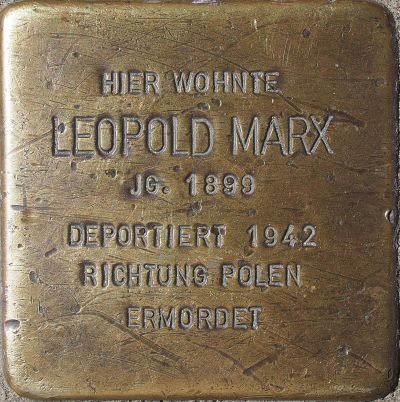
Visiting the Stolperstein for Leopold Marx in Mainz, Germany: A Complete Guide
Introduction
The Stolperstein dedicated to Leopold Marx in Mainz, Germany, offers a poignant and personal encounter with the history of the Holocaust. This guide provides comprehensive information about the Stolperstein, its historical context, visiting logistics, and nearby attractions, enabling a meaningful engagement with this important memorial.
The Stolpersteine Project: Origins and Purpose
The Stolpersteine (“stumbling stones”) project, initiated by German artist Gunter Demnig in 1992, is the world’s largest decentralized memorial. It commemorates victims of Nazi persecution by embedding small, brass-plated cobblestones into the pavement in front of their last freely chosen residences (Stolperstein). Each stone is engraved with the victim’s name, date of birth, fate, and, if known, date and place of death (Stolpersteine.eu). The project aims to personalize the memory of the Holocaust, bringing history into the everyday landscape and prompting reflection (Germany.info).
Leopold Marx and the Jewish Community of Mainz
Mainz, one of the historic ShUM cities, boasts a rich Jewish heritage dating back to the Middle Ages (Mainz Tourism). The Stolperstein for Leopold Marx, located in the Finthen district, memorializes a member of this once-thriving community. His story, along with those of other victims commemorated by Stolpersteine in Mainz, reflects the broader narrative of persecution and loss during the Holocaust (Haus des Erinnerns Mainz). Researching Leopold Marx’s life and the history of Mainz’s Jewish community can significantly enhance a visit to the Stolperstein (Stolpersteinprojekt Mainz).
Visiting the Stolperstein for Leopold Marx
Location and Accessibility
The Stolperstein is located in Mainz-Finthen at Leopold Marx’s last freely chosen residence. The specific address can be found through online resources like Mapcarta: Stolperstein Leopold Marx. The Stolperstein is embedded in the sidewalk and is publicly accessible at any time. The location is generally accessible for visitors with mobility issues, though it’s advisable to be mindful of typical street conditions.
Visiting Hours and Tickets
As the Stolperstein is a public memorial in the sidewalk, there are no specific visiting hours or admission fees. It can be visited at any time, day or night.
Guided Tours
Guided tours focusing on Mainz’s Stolpersteine and Jewish heritage are available through local organizations like Haus des Erinnerns and the Mainz tourism office. These tours provide valuable historical context and personalize the stories behind the stones (Mainz Tourism).
Nearby Historical Sites
Consider combining your visit with other relevant sites in Mainz, such as:
- The Mainz Synagogue
- The Jewish Museum Mainz
- The historic Old Town and ShUM city landmarks (Mainz Tourism)
Educational and Cultural Significance
The Stolpersteine project offers a powerful form of experiential learning. By encountering these memorials in everyday life, individuals are prompted to reflect on the history of the Holocaust and its impact on individuals and communities. The project also fosters community involvement through research, fundraising, and installation ceremonies (Wikipedia: Stolperstein; Fabrizio Musacchio).
Frequently Asked Questions
Q: How can I find the exact location of the Stolperstein? A: Online resources like Mapcarta and the Stolpersteine project website provide location information.
Q: Are there any costs associated with visiting? A: No, the Stolperstein is a public memorial and is free to visit.
Q: Is the Stolperstein accessible for people with mobility impairments? A: Generally yes, but be aware of potential uneven surfaces.
Q: Are there guided tours available? A: Yes, contact the Mainz tourism office or local organizations like Haus des Erinnerns.
Conclusion
Visiting the Stolperstein for Leopold Marx is a powerful way to connect with the history of the Holocaust and honor the memory of its victims. By engaging with this memorial and the resources available, visitors can contribute to a culture of remembrance and understanding.


































































































































